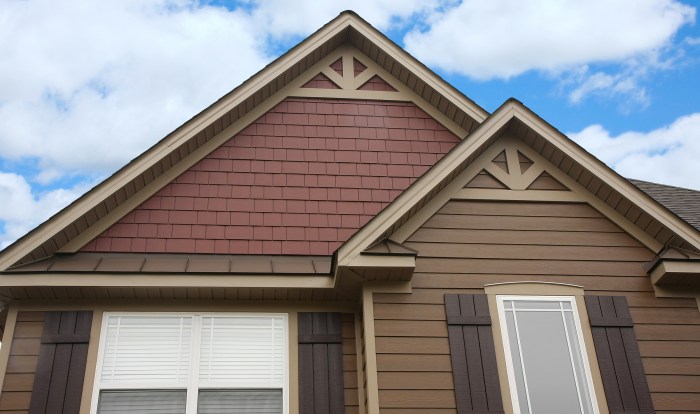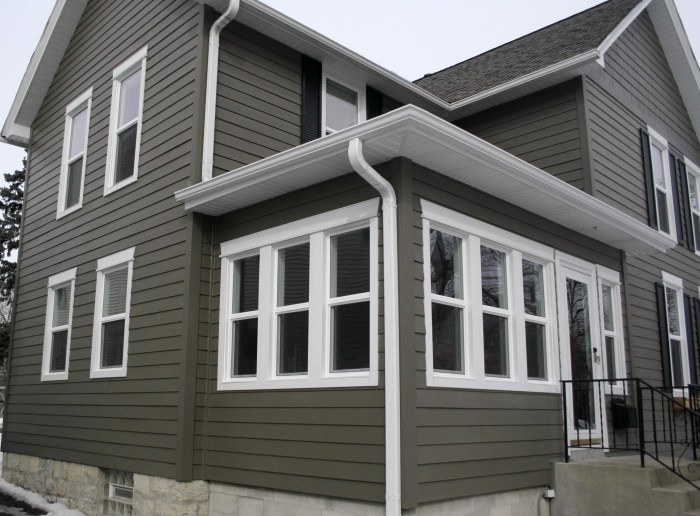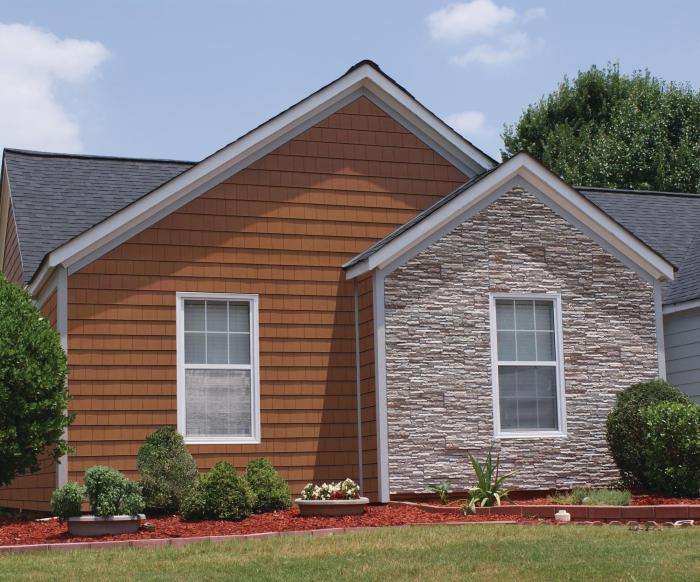Hardyboard, a durable and versatile building material, offers a compelling alternative to traditional siding options. Its composition, typically cement fiber, provides exceptional strength and resistance to the elements, making it a popular choice for both residential and commercial projects. This guide delves into the multifaceted world of hardyboard, exploring its manufacturing process, diverse applications, and crucial considerations for installation and maintenance.
From understanding its inherent advantages and disadvantages to mastering installation techniques and appreciating its aesthetic potential, we aim to equip you with the knowledge needed to make informed decisions when incorporating hardyboard into your next construction endeavor. We’ll examine its cost-effectiveness against other materials, explore various finishes, and even design a small shed using hardyboard as the primary cladding. Prepare to discover the remarkable versatility and enduring qualities of this exceptional building material.
What is Hardyboard?

Hardyboard, also known as cement board or fiber cement siding, is a type of exterior cladding material increasingly popular in construction for its durability and versatility. It’s a composite material consisting primarily of Portland cement, cellulose fibers, and silica sand. These ingredients are combined and formed into large sheets, then cured and finished for installation. The resulting product offers a robust and weather-resistant alternative to traditional materials like wood and vinyl.
Hardyboard Composition and Manufacturing
Hardyboard’s strength and longevity stem from its specific composition. Portland cement provides the binding agent and contributes significantly to the material’s compressive strength. Cellulose fibers, often derived from recycled paper, add tensile strength and flexibility, preventing cracking and brittleness. Silica sand acts as a filler, contributing to the overall bulk and density of the board. The manufacturing process involves mixing these components with water, forming the mixture into large sheets under high pressure, and then curing them in a controlled environment to allow the cement to fully hydrate and harden. This process results in a dense, non-porous board resistant to moisture, rot, and insect infestation. The final product is often treated with a surface coating to enhance its aesthetic appeal and weather resistance.
Comparison with Plywood and Drywall
Compared to plywood, hardyboard offers superior resistance to moisture and rot, making it ideal for exterior applications and areas prone to humidity. Plywood, while versatile and relatively inexpensive, is susceptible to water damage, which can lead to warping, swelling, and eventual structural failure. Drywall, commonly used for interior walls, lacks the durability and weather resistance of hardyboard. It’s significantly more vulnerable to impact damage and moisture penetration, making it unsuitable for exterior applications. Hardyboard’s superior strength and weather resistance translate to a longer lifespan and reduced maintenance compared to both plywood and drywall in appropriate applications.
Types of Hardyboard and Their Applications
Various types of hardyboard exist, each designed for specific applications. For instance, some products are formulated for use as exterior siding, featuring textured surfaces designed to mimic wood or stone. Other types are designed for interior use, offering a moisture-resistant substrate for tiling in bathrooms or kitchens. There are also specialized types designed for use in fire-rated applications, offering enhanced fire resistance compared to standard building materials. The choice of hardyboard depends on the specific requirements of the project, considering factors such as location, environmental conditions, and intended use. For example, a home located in a coastal region might benefit from a hardyboard siding with enhanced resistance to salt spray and UV degradation. Conversely, a kitchen backsplash might utilize a thinner, more easily cuttable version of the material.
Hardyboard Applications in Construction
Hardyboard, a cement-fiber composite material, offers a durable and versatile solution for various exterior and interior cladding applications in both residential and commercial construction. Its inherent resistance to moisture, fire, and pests makes it a popular choice for projects demanding long-term performance and low maintenance. This section will detail the common uses of hardyboard across different building types, and illustrate its application through a hypothetical project.
Residential Hardyboard Applications
Hardyboard finds widespread use in residential construction as a siding material. Its smooth, paintable surface allows for a wide range of aesthetic choices, complementing various architectural styles. Common applications include exterior wall cladding, soffits, and fascia boards. Its durability makes it ideal for areas prone to harsh weather conditions, ensuring longevity and minimizing the need for frequent repairs or replacements. Furthermore, hardyboard’s resistance to rot and insect infestation contributes to a healthier and more sustainable building envelope. Many homeowners choose hardyboard for its low maintenance requirements, saving time and money in the long run.
Commercial Hardyboard Applications
The robust nature of hardyboard extends its utility to commercial building projects. Large-scale applications include exterior wall cladding for office buildings, retail spaces, and industrial structures. Its fire-resistant properties make it a suitable choice for high-occupancy buildings, enhancing safety and meeting stringent building codes. The material’s resistance to impact and vandalism also makes it a cost-effective solution for areas with higher security concerns. Hardyboard’s ease of installation and consistent quality contribute to efficient project completion, reducing labor costs and project timelines.
Hypothetical Small Shed Construction Using Hardyboard
This section Artikels a plan for a small 8ft x 6ft shed using hardyboard as the primary exterior cladding.
Materials List:
- Hardyboard sheets (sufficient to cover exterior walls and roof)
- Pressure-treated lumber for framing
- Roofing felt
- Asphalt shingles or metal roofing
- Nails, screws, and other fasteners
- Exterior-grade paint or stain
- Window and door units (optional)
Construction Plan:
The construction would follow standard shed-building practices. First, a pressure-treated lumber frame would be constructed, ensuring proper foundation and bracing. Then, the hardyboard sheets would be attached to the frame, overlapping joints for water tightness. Roofing felt would be installed, followed by the chosen roofing material. Finally, the shed would be painted or stained for protection and aesthetics. This simple design leverages the ease of installation and durability of hardyboard to create a robust and long-lasting structure.
Cost Comparison of Hardyboard vs. Alternative Cladding Materials
The following table compares the cost-effectiveness of hardyboard against common alternative cladding materials for a small residential project (assuming a 100 sq ft area). These figures are estimates and may vary depending on location, supplier, and labor costs.
| Material | Cost per unit | Installation Cost | Total Cost |
|---|---|---|---|
| Hardyboard | $20/sheet (approx. 4ft x 8ft) | $500 | $1000 – $1200 |
| Vinyl Siding | $2/sq ft | $400 | $600 |
| Wood Siding | $4/sq ft | $600 | $1000 |
| Brick | $10/sq ft | $1000 | $2000 |
Advantages and Disadvantages of Hardyboard

Hardyboard, a type of fiber cement siding, offers a compelling blend of durability and aesthetics for exterior cladding. However, like any building material, it presents both advantages and disadvantages that builders and homeowners should carefully consider before making a selection. Understanding these aspects is crucial for informed decision-making and ensuring long-term satisfaction with the chosen material.
Key Advantages of Hardyboard
Hardyboard’s popularity stems from several key benefits. Its inherent strength and resilience make it highly resistant to damage from impacts, harsh weather conditions, and insect infestations. This translates to lower maintenance costs and a longer lifespan compared to some alternative siding materials. Furthermore, its non-combustible nature enhances fire safety, a significant advantage in areas prone to wildfires or where stringent building codes apply. Finally, hardyboard offers considerable design flexibility, accommodating a wide range of colors, textures, and styles to complement various architectural designs. Its ability to mimic the look of wood without the associated maintenance requirements makes it a particularly attractive option.
Potential Drawbacks of Hardyboard
Despite its numerous advantages, hardyboard is not without its drawbacks. One significant consideration is its weight, which can make installation more challenging and potentially increase labor costs. The material is also susceptible to cracking if not installed properly, highlighting the importance of employing skilled professionals for installation. Furthermore, while resistant to many forms of damage, hardyboard can be susceptible to water damage if not sealed correctly, leading to potential issues with rot or deterioration. Finally, the initial cost of hardyboard can be higher than some alternative siding options, although this is often offset by its longevity and reduced maintenance needs.
Environmental Impact of Hardyboard
The environmental impact of hardyboard is a complex issue. Its production involves the use of cement, a significant carbon emitter. However, the use of recycled materials in some manufacturing processes helps to mitigate this impact. Furthermore, the long lifespan of hardyboard reduces the frequency of replacement, lessening the overall environmental burden associated with material production and disposal. Responsible disposal methods, such as recycling or proper waste management, are crucial to minimize the environmental footprint at the end of the product’s life cycle. The overall environmental impact requires a life-cycle assessment considering production, usage, and disposal to provide a complete picture. For example, a comparison against vinyl siding would need to consider the embodied carbon of both materials and the energy used during manufacturing.
Lifespan and Maintenance Compared to Other Siding Options
Hardyboard boasts a significantly longer lifespan compared to many other siding options. While the precise lifespan depends on factors like climate and maintenance, it generally outperforms wood siding (which requires regular painting and is susceptible to rot and insect damage) and vinyl siding (which can become brittle and fade over time). Maintenance requirements are also minimal, typically involving occasional cleaning to remove dirt and debris. This contrasts sharply with the more intensive maintenance needs of wood siding, which often requires repainting every few years. A comparison of lifecycle costs, considering initial purchase price, installation, maintenance, and eventual replacement, would generally favor hardyboard, particularly over materials with shorter lifespans and higher maintenance needs. For instance, a 30-year lifespan for hardyboard versus a 15-year lifespan for vinyl siding will significantly impact the total cost of ownership over the long term.
Installation and Maintenance of Hardyboard

Hardyboard installation requires careful planning and execution to ensure a durable and aesthetically pleasing exterior. Proper techniques for cutting, fastening, and maintaining the material are crucial for maximizing its lifespan and preventing costly repairs. This section details the steps involved in installation and provides guidance on maintaining your hardyboard siding.
Hardyboard Siding Installation
Installing hardyboard siding involves several key steps. First, prepare the surface by ensuring it is clean, dry, and free from any debris or loose materials. Next, install appropriate flashing and water barriers to protect the underlying structure from moisture. Then, begin installing the siding, starting at a corner and working your way across. Maintain consistent spacing between panels and use appropriate fasteners. Finally, seal all seams and edges with appropriate caulk to prevent water penetration. This systematic approach guarantees a long-lasting and weather-resistant exterior.
Cutting and Fastening Hardyboard
Cutting hardyboard requires specialized tools to prevent chipping and ensure clean cuts. A circular saw with a fine-tooth blade designed for cutting fiber cement is recommended. Always wear appropriate safety gear, including eye protection and a dust mask. Fastening the hardyboard is equally important. Use corrosion-resistant nails or screws specifically designed for exterior use. These should be driven straight and flush with the surface to avoid damage and ensure a secure hold. Overdriving fasteners can cause cracking, so careful attention is necessary. Proper fastening techniques prevent issues with wind uplift and water intrusion.
Hardyboard Maintenance Procedures
Regular maintenance is key to extending the life of hardyboard siding. Periodically inspect the siding for any signs of damage, such as cracks, loose fasteners, or water damage. Clean the siding with a pressure washer using a low-pressure setting to avoid damaging the surface. For stubborn stains, a mild detergent solution can be used. Avoid abrasive cleaners or harsh chemicals that could damage the finish. Regular cleaning prevents the buildup of dirt and grime, which can lead to premature deterioration.
Repairing Minor Damage to Hardyboard
Minor damage, such as small cracks or chips, can often be repaired with a specialized filler designed for fiber cement. The area should be cleaned and dried before applying the filler. Once the filler has dried, sand it smooth and apply a matching paint or sealant to blend the repair with the surrounding siding. For more significant damage, replacement panels may be necessary. Using appropriate repair materials and techniques ensures a seamless and long-lasting repair, maintaining the aesthetic integrity of the siding.
Hardyboard and its Aesthetics
Hardyboard, while renowned for its durability and weather resistance, also offers surprising aesthetic versatility. Its ability to mimic the look of other materials, coupled with its smooth, paintable surface, allows for a wide range of design possibilities, making it a popular choice for both traditional and modern homes. The inherent clean lines of the material provide a blank canvas for homeowners to express their personal style.
Hardyboard’s aesthetic appeal lies in its ability to seamlessly integrate into diverse architectural styles. Its adaptability allows for both subtle and bold design choices, transforming the exterior of a home from ordinary to extraordinary. The versatility of this material extends beyond simple siding, encompassing applications in roofing underlayment, soffits, and even interior wall cladding, creating a cohesive and stylish aesthetic throughout the entire structure.
Available Finishes and Textures
The range of finishes and textures available for hardyboard significantly expands its design potential. Pre-finished options offer a variety of colors and patterns, eliminating the need for on-site painting and reducing installation time. These pre-finished boards can mimic the look of wood grain, stone, or even stucco, providing homeowners with a wide selection to match their architectural preferences. For a more customized look, the smooth surface of the untreated hardyboard accepts paint flawlessly, allowing for unlimited color choices and the creation of unique textures through specialized painting techniques. Textured finishes, such as those designed to replicate wood siding, add depth and visual interest to the façade.
Integrating Hardyboard with Other Building Materials
Hardyboard’s compatibility with other building materials is a key factor in its design versatility. It can be seamlessly integrated with traditional wood trim, creating a classic and elegant look. The clean lines of hardyboard complement the intricate details of wood trim, offering a balanced and sophisticated aesthetic. Modern homes might pair hardyboard with metal accents, such as sleek window frames or decorative metal panels, for a contemporary feel. The use of contrasting colors and materials enhances the visual appeal, emphasizing the architectural features of the building. Furthermore, hardyboard can be used in conjunction with stone or brick, providing a sophisticated blend of textures and materials. The combination of hardyboard’s smooth surface with the rugged texture of stone or brick creates a visually interesting and durable exterior.
Example of a House with Hardyboard Siding
Imagine a two-story craftsman-style home clad in deep charcoal gray hardyboard siding. The siding’s smooth surface provides a clean backdrop for the intricate detailing of the home’s architecture. Crisp white trim accents the windows, doors, and eaves, creating a striking contrast against the dark siding. The deep charcoal gray conveys a sense of sophistication and modernity, while the white trim adds a touch of classic elegance. A gently pitched roof, covered in dark gray asphalt shingles, complements the siding’s color scheme. The overall effect is a sophisticated and timeless aesthetic, showcasing the versatility of hardyboard in creating a visually appealing and durable exterior.
Hardyboard emerges as a robust and aesthetically pleasing solution for a wide range of construction projects. Its resilience, ease of maintenance, and design flexibility make it a compelling choice for homeowners and builders alike. By understanding its properties, installation methods, and potential limitations, you can confidently leverage hardyboard’s advantages to create durable, visually appealing structures that stand the test of time. Whether you’re building a small shed or a large-scale commercial project, the information provided here will serve as a valuable resource in your decision-making process.
Helpful Answers: Hardyboard
Is hardyboard susceptible to mold and mildew?
While hardyboard is resistant to moisture damage, proper ventilation and sealing are crucial to prevent mold and mildew growth, especially in humid climates.
Can I paint hardyboard?
Yes, hardyboard can be painted with exterior-grade paints designed for cement-based materials. Proper surface preparation is key for optimal adhesion and longevity.
How long does hardyboard last?
With proper installation and maintenance, hardyboard siding can last for several decades, often outperforming other siding materials in terms of lifespan.
What tools are needed to install hardyboard?
Essential tools include a circular saw (with a carbide-tipped blade for clean cuts), measuring tape, level, drill, screws, and appropriate safety gear.
Is hardyboard difficult to install?
While manageable for DIYers with some construction experience, professional installation is recommended for complex projects to ensure proper results and avoid potential issues.


